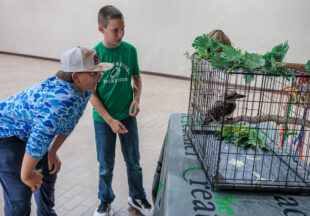Local ranchers, farmers identify biggest conservation resource concerns for USDA

Local ranchers and farmers have identified “degraded plant condition” as the most important resource concern on rangeland, pastureland and cropland, according to information gathered in a meeting this summer. Livestock production was the second most pressing resource concern on rangeland and pastureland, and soil erosion on cropland.
The Stephens and Shackelford County fiscal year 2019 Local Working Group sponsored by the USDA Natural Resources Conservation Service and the Lower Clear Fork of the Brazos Soil and Water Conservation District was held on July 26 at Breckenridge Inter Bank.
The meeting brought together producers from Stephens and Shackelford counties to set local conservation resource concerns which should be addressed and to voice their opinions on what practices should be prioritized through USDA conservation efforts, whether through providing technical assistance or through financial assistance programs, such as the Environmental Quality Incentives Program. The meeting also updated producers on recent conservation efforts by the NRCS and the Lower Clear Fork of the Brazos SWCD in both counties.
Every piece of property is unique with opportunities to improve natural resources and address any areas of concern, the NRCS explained in a news release. Human activities contribute to the condition of natural resources on the land – they can help improve them or contribute to their decline, which can result in what NRCS refers to as a “resource concern.” Most landowners have several goals in mind on their operation. It may be to improve grass production or build a pond or improve wildlife habitat. A resource concern is something that may be preventing them from reaching those goals. NRCS staff are experts trained at evaluating natural resources on the land – soil, water, air, plants and animals and determining if any of those resources could use a little improvement.
“Each year farmers, ranchers, conservationists, and others interested in directing the agency’s conservation efforts on private lands in Stephens and Shackelford Counties are invited to participate in the Local Work Group,” said Tony Baeza, District Conservationist for the NRCS office in Breckenridge. “This allows producers to have a local say on what direction the conservation programs in their respective counties should be heading toward.”
To address the resources concerns, producers in Stephens County said that brush management is the most important practice on rangeland and pastureland, followed by livestock water development and cross fencing on rangeland and livestock water development and prescribed grazing on pastureland. Seeding permanent grass on cropland was selected as the most important practice on cropland followed by cover crop and livestock water development.
Troy Reinke, District Conservationist, for the NRCS office in Albany reported that Shackelford County producers identified degraded plant condition as the resource concern of most concern in their county on rangeland and cropland. That was followed by livestock production limitations on rangeland and soil quality degradation on cropland. Inadequate habitat and degraded plant condition were the top two resource concerns on pastureland.
Reinke added that that that brush management is the most important practice on rangeland, followed by livestock water development. Upland wildlife habitat management and livestock water development were the top two priority practices on pastureland. Seeding permanent grass on cropland was selected as the most important practice on cropland followed by cover crop and no till farming.
Baeza said that the outcome from the LWG will have a direct effect on the NRCS conservation efforts in Stephens and Shackelford Counties, especially when it comes to the EQIP program.
For more information on how to get technical and financial assistance on conservation resource concerns contact the NRCS office in Breckenridge at 254-559-2333 ext. 3 or the NRCS office in Albany at 325-762-2277 or visit the NRCS Web site at http://www.tx.nrcs.usda.gov/.
Information provided by the USDA Natural Resources Conservation Service
Cutline, top photo: Degraded plant condition and livestock production were identified as the top two resource concerns by producers in Stephens County. Brush management and livestock water development are practices that can address those concerns. (Photo by the USDA-NRCS)































































































